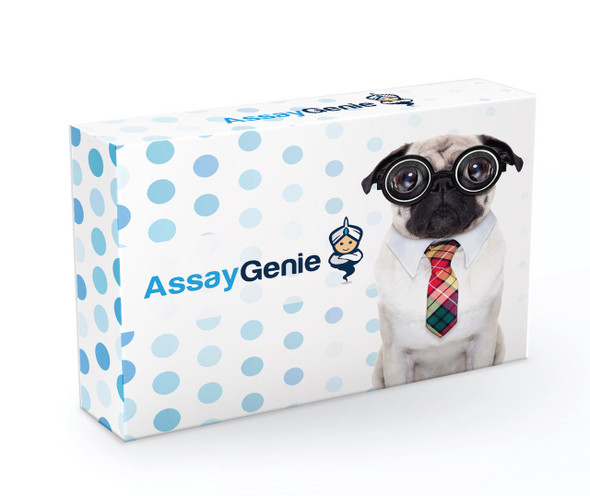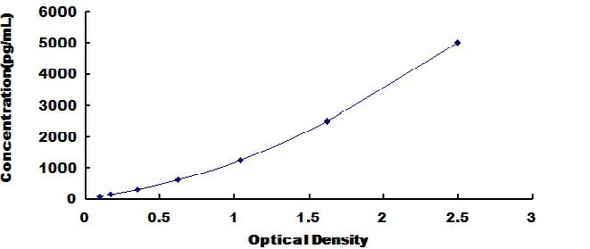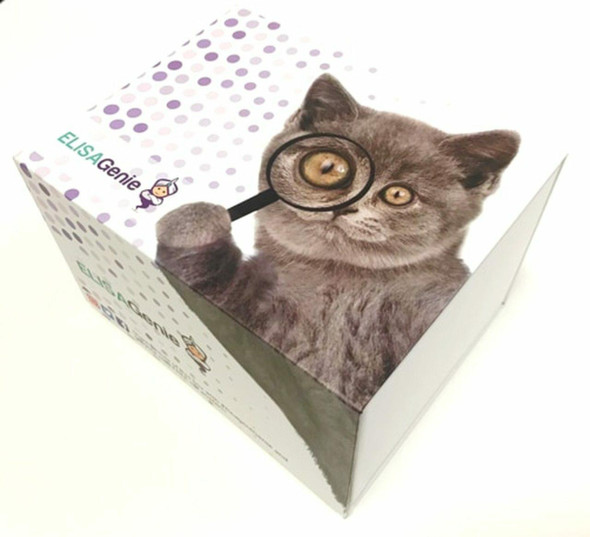Mouse Cell Death ELISA Kits
Mouse S100A8 (S100 Calcium Binding Protein A8) CLIA Kit (MOES00608)
- SKU:
- MOES00608
- Product Type:
- ELISA Kit
- ELISA Type:
- CLIA Kit
- Size:
- 96 Assays
- Sensitivity:
- 75pg/mL
- Range:
- 125-8000pg/mL
- ELISA Type:
- Sandwich
- Synonyms:
- 60B8AG, CAGA, CFAG, CGLA, CP-10, L1Ag, MA387, MIF, MRP8, NIF, P8, Calgranulin A
- Reactivity:
- Mouse
- Sample Type:
- Serum, plasma and other biological fluids
- Research Area:
- Cell Death
Description
| Assay type: | Sandwich |
| Format: | 96T |
| Assay time: | 4.5h |
| Reactivity: | Mouse |
| Detection method: | Chemiluminescence |
| Detection range: | 125.00-8000 pg/mL |
| Sensitivity: | 75.00 pg/mL |
| Sample volume: | 100µL |
| Sample type: | Serum, plasma and other biological fluids |
| Repeatability: | CV < 15% |
| Specificity: | This kit recognizes Mouse S100A8 in samples. No significant cross-reactivity or interference between Mouse S100A8 and analogues was observed. |
This kit uses Sandwich-CLIA as the method. The micro CLIA plate provided in this kit has been pre-coated with an antibody specific to Mouse S100A8. Standards or samples are added to the appropriate micro CLIA plate wells and combined with the specific antibody. Then a biotinylated detection antibody specific for Mouse S100A8 and Avidin-Horseradish Peroxidase (HRP) conjugate are added to each micro plate well successively and incubated. Free components are washed away. The substrate solution is added to each well. Only those wells that contain Mouse S100A8, biotinylated detection antibody and Avidin-HRP conjugate will appear fluorescence. The Relative light unit (RLU) value is measured spectrophotometrically by the Chemiluminescence immunoassay analyzer. The RLU value is positively associated with the concentration of Mouse S100A8. The concentration of Mouse S100A8 in the samples can be calculated by comparing the RLU of the samples to the standard curve.
| UniProt Protein Function: | S100A8: S100A8 is a calcium- and zinc-binding protein which plays a prominent role in the regulation of inflammatory processes and immune response. It can induce neutrophil chemotaxis and adhesion. Predominantly found as calprotectin (S100A8/A9) which has a wide plethora of intra- and extracellular functions. The intracellular functions include: facilitating leukocyte arachidonic acid trafficking and metabolism, modulation of the tubulin-dependent cytoskeleton during migration of phagocytes and activation of the neutrophilic NADPH-oxidase. Activates NADPH- oxidase by facilitating the enzyme complex assembly at the cell membrane, transfering arachidonic acid, an essential cofactor, to the enzyme complex and S100A8 contributes to the enzyme assembly by directly binding to NCF2/P67PHOX. The extracellular functions involve proinfammatory, antimicrobial, oxidant-scavenging and apoptosis-inducing activities. Its proinflammatory activity includes recruitment of leukocytes, promotion of cytokine and chemokine production, and regulation of leukocyte adhesion and migration. Acts as an alarmin or a danger associated molecular pattern (DAMP) molecule and stimulates innate immune cells via binding to pattern recognition receptors such as Toll-like receptor 4 (TLR4) and receptor for advanced glycation endproducts (AGER). Binding to TLR4 and AGER activates the MAP-kinase and NF- kappa-B signaling pathways resulting in the amplification of the proinflammatory cascade. Has antimicrobial activity towards bacteria and fungi and exerts its antimicrobial activity probably via chelation of Zn(2+) which is essential for microbial growth. Can induce cell death via autophagy and apoptosis and this occurs through the cross-talk of mitochondria and lysosomes via reactive oxygen species (ROS) and the process involves BNIP3. Can regulate neutrophil number and apoptosis by an anti-apoptotic effect; regulates cell survival via ITGAM/ITGB and TLR4 and a signaling mechanism involving MEK-ERK. Its role as an oxidant scavenger has a protective role in preventing exaggerated tissue damage by scavenging oxidants. Can act as a potent amplifier of inflammation in autoimmunity as well as in cancer development and tumor spread. Belongs to the S-100 family. |
| UniProt Protein Details: | Chromosomal Location of Human Ortholog: 3 F1|3 39. 9 cM Cellular Component: extracellular space; nucleus Biological Process: astrocyte development; autophagy; caspase activation; leukocyte migration during inflammatory response; neutrophil chemotaxis; peptidyl-cysteine S-nitrosylation; positive regulation of inflammatory response; positive regulation of peptide secretion |
| UniProt Code: | P27005 |
| NCBI GenInfo Identifier: | 1173338 |
| NCBI Gene ID: | 20201 |
| NCBI Accession: | P27005. 3 |
| UniProt Secondary Accession: | P27005,P31724, |
| UniProt Related Accession: | P27005 |
| Molecular Weight: | 10,295 Da |
| NCBI Full Name: | Protein S100-A8 |
| NCBI Synonym Full Names: | S100 calcium binding protein A8 (calgranulin A) |
| NCBI Official Symbol: | S100a8 |
| NCBI Official Synonym Symbols: | p8; B8Ag; CFAg; Caga; MRP8; CP-10; 60B8Ag; AI323541 |
| NCBI Protein Information: | protein S100-A8 |
| UniProt Protein Name: | Protein S100-A8 |
| UniProt Synonym Protein Names: | Calgranulin-A; Chemotactic cytokine CP-10; Leukocyte L1 complex light chain; Migration inhibitory factor-related protein 8; MRP-8; p8; Pro-inflammatory S100 cytokine; S100 calcium-binding protein A8 |
| Protein Family: | Protein |
| UniProt Gene Name: | S100a8 |
As the RLU values of the standard curve may vary according to the conditions of the actual assay performance (e. g. operator, pipetting technique, washing technique or temperature effects), the operator should establish a standard curve for each test. Typical standard curve and data is provided below for reference only.
| Concentration (pg/mL) | RLU | Average | Corrected |
| 8000 | 68511 74367 | 71439 | 71418 |
| 4000 | 35444 35552 | 35498 | 35477 |
| 2000 | 17927 17181 | 17554 | 17533 |
| 1000 | 8252 8924 | 8588 | 8567 |
| 500 | 4128 4086 | 4107 | 4086 |
| 250 | 1890 1844 | 1867 | 1846 |
| 125.00 | 703 791 | 747 | 726 |
| 0 | 20 22 | 21 | -- |
Precision
Intra-assay Precision (Precision within an assay): 3 samples with low, mid range and high level Mouse S100A8 were tested 20 times on one plate, respectively.
Inter-assay Precision (Precision between assays): 3 samples with low, mid range and high level Mouse S100A8 were tested on 3 different plates, 20 replicates in each plate.
| Intra-assay Precision | Inter-assay Precision | |||||
| Sample | 1 | 2 | 3 | 1 | 2 | 3 |
| n | 20 | 20 | 20 | 20 | 20 | 20 |
| Mean (pg/mL) | 423.00 | 689.84 | 2927.46 | 438.01 | 709.05 | 3196.54 |
| Standard deviation | 44.80 | 81.95 | 321.14 | 43.80 | 58.64 | 349.70 |
| C V (%) | 10.59 | 11.88 | 10.97 | 10.00 | 8.27 | 10.94 |
Recovery
The recovery of Mouse S100A8 spiked at three different levels in samples throughout the range of the assay was evaluated in various matrices.
| Sample Type | Range (%) | Average Recovery (%) |
| Serum (n=5) | 93-108 | 100 |
| EDTA plasma (n=5) | 90-105 | 97 |
| Cell culture media (n=5) | 98-111 | 105 |
Linearity
Samples were spiked with high concentrations of Mouse S100A8 and diluted with Reference Standard & Sample Diluent to produce samples with values within the range of the assay.
| Serum (n=5) | EDTA plasma (n=5) | Cell culture media (n=5) | ||
| 1:2 | Range (%) | 90-100 | 85-100 | 103-115 |
| Average (%) | 95 | 92 | 108 | |
| 1:4 | Range (%) | 96-113 | 90-101 | 90-106 |
| Average (%) | 104 | 96 | 98 | |
| 1:8 | Range (%) | 93-106 | 98-111 | 94-108 |
| Average (%) | 100 | 105 | 102 | |
| 1:16 | Range (%) | 93-108 | 85-97 | 87-100 |
| Average (%) | 100 | 90 | 93 |
An unopened kit can be stored at 4°C for 1 month. If the kit is not used within 1 month, store the items separately according to the following conditions once the kit is received.
| Item | Specifications | Storage |
| Micro CLIA Plate(Dismountable) | 8 wells ×12 strips | -20°C, 6 months |
| Reference Standard | 2 vials | |
| Concentrated Biotinylated Detection Ab (100×) | 1 vial, 120 µL | |
| Concentrated HRP Conjugate (100×) | 1 vial, 120 µL | -20°C(shading light), 6 months |
| Reference Standard & Sample Diluent | 1 vial, 20 mL | 4°C, 6 months |
| Biotinylated Detection Ab Diluent | 1 vial, 14 mL | |
| HRP Conjugate Diluent | 1 vial, 14 mL | |
| Concentrated Wash Buffer (25×) | 1 vial, 30 mL | |
| Substrate Reagent A | 1 vial, 5 mL | 4°C (shading light) |
| Substrate Reagent B | 1 vial, 5 mL | 4°C (shading light) |
| Plate Sealer | 5 pieces | |
| Product Description | 1 copy | |
| Certificate of Analysis | 1 copy |
- Set standard, test sample and control (zero) wells on the pre-coated plate and record theirpositions. It is recommended to measure each standard and sample in duplicate. Note: addall solutions to the bottom of the plate wells while avoiding contact with the well walls. Ensuresolutions do not foam when adding to the wells.
- Aliquot 100 µL of standard solutions into the standard wells.
- Add 100 µL of Sample / Standard dilution buffer into the control (zero) well.
- Add 100 µL of properly diluted sample (serum, plasma, tissue homogenates and otherbiological fluids. ) into test sample wells.
- Cover the plate with the sealer provided in the kit and incubate for 90 min at 37 °C.
- Aspirate the liquid from each well, do not wash. Immediately add 100 µL of BiotinylatedDetection Ab working solution to each well. Cover the plate with a plate seal and gently mix. Incubate for 1 hour at 37 °C.
- Aspirate or decant the solution from the plate and add 350 µL of wash buffer to each welland incubate for 1-2 minutes at room temperature. Aspirate the solution from each well andclap the plate on absorbent filter paper to dry. Repeat this process 3 times. Note: a microplatewasher can be used in this step and other wash steps.
- Add 100 µL of HRP Conjugate working solution to each well. Cover with a plate seal andincubate for 30 min at 37 °C.
- Aspirate or decant the solution from each well. Repeat the wash process for five times asconducted in step 7.
- Add 100 µL of Substrate mixture solution to each well. Cover with a new plate seal andincubate for no more than 5 min at 37 °C. Protect the plate from light.
- Determine the RLU value of each well immediately.






